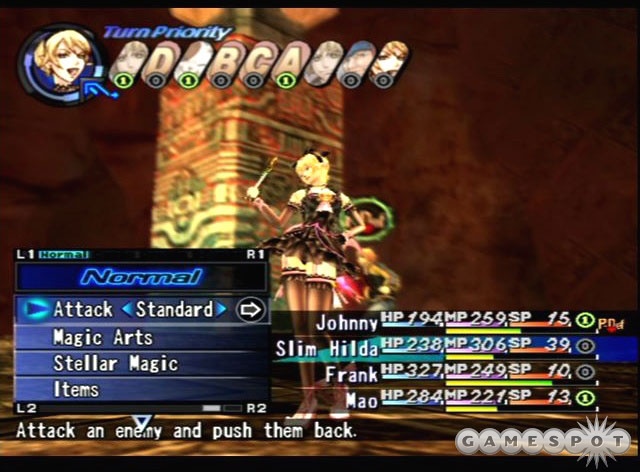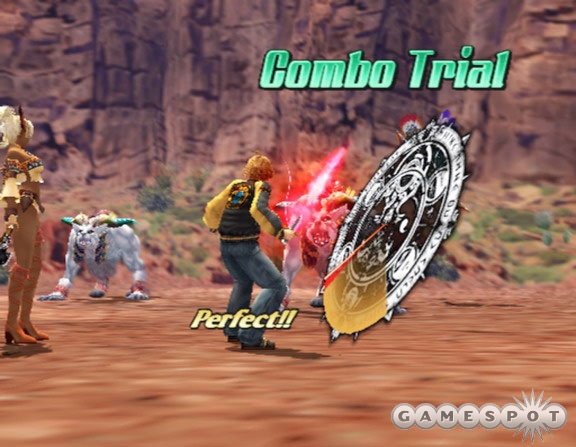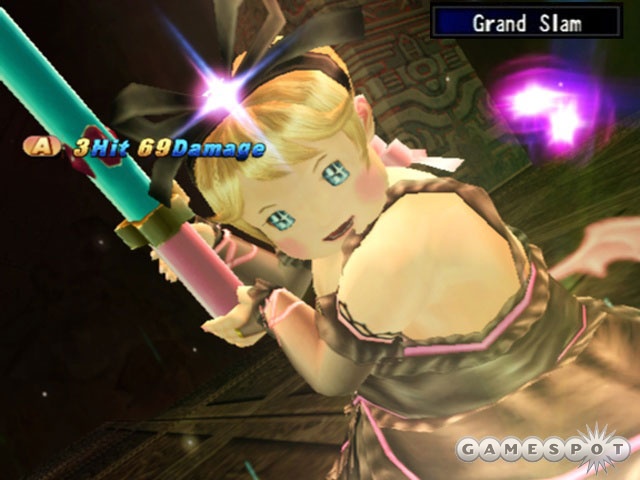The Shadow Hearts series has been steadily gathering notice in the realm of console role-playing games, due in large part to its great gameplay, bizarre occult-laced narrative set in the world of the early 1900s, and consistently crazy characters and humor. Shadow Hearts: From the New World brings all those series staples to the Depression-era Americas, with some new twists. While some of the changes seem to pile on unnecessary complexity, the basic Shadow Hearts formula still provides a great time for RPG aficionados.

Johnny Garland is a fresh-faced 16-year-old living in New York City, with a plucky nature and an adventurous spirit. After the tragic deaths of his father and sister, he eschews taking up the helm of the family business and instead turns to his own enterprise--a detective agency. Most of the jobs are disappointingly small, until a mysterious professor from Boston arrives on his doorstep, needing to track down a certain man. It's a routine-enough venture to locate the suspect, until a portal opens directly behind him, disgorging a demon who promptly murders Johnny's screaming assignment. Oops. Now that reality's gone a little haywire, the young man sets off on a journey to uncover the truth behind the professor's strange experiments, behind the acts of some serial murderers, and behind his own clouded past.
Much like in previous Shadow Hearts games, the host of characters that come to Johnny's aid form the most bewildering RPG menagerie ever assembled. The most "normal" of the set is probably Shania, the voluptuous young woman from the Gavoy tribe who has the power to commune with and assume the form of powerful spirits. The assortment of other characters includes her Gavoy tribesman Natan, who is a master of "gun-fu," which is equal parts martial arts and firearms; Frank, a flamboyant American ninja who learned his arts in a remote fortress in the Amazon; Hilda, a vampire whose combat abilities depend on the number of calories she's ingested; and more. When you include the cat who's a master of drunken-style combat and the enigmatic Ricardo, the cast itself is enough to send your head spinning. Throw in the cheery homosexual duo who follow you around the world to offer you a chance to buy supplies, and consider that you do things like bust Al Capone out of Alcatraz, and you know you're in for a good time. The storyline remains compelling (if insane) throughout, and when it's not, there's always the combat to fall back on.
The judgment ring is the basis for the combat system, but a number of other aspects of the game--everything from earning item discounts, to playing lottery minigames, to using items in battle--involve the ring. Each time you select an action in combat, a disc appears with a sweeping line traveling around it and colored segments, and the idea is to hit the X button while the line is passing through the segments. Do so, and your action will be successful. If you miss segments, you can lose some melee hits or even fail your intended move altogether. While you can set the ring to auto-hit the correct areas, you lose some of the bonuses. Many of the melee hit rings have "strike" areas--slim red slices on the very edge of attack segments. If you hit these, your attacks will be more powerful. Likewise, much of the magic in the game has a gradient effect, so the further into the colored section you click, the more powerful your spell will be.

There's also the fact that mastering and properly taking advantage of the judgment ring is extremely gratifying. With practice, you'll hardly ever flub your moves, and you'll soon find the correct cadence to hit a given character's strike zones efficiently, even pulling off multicharacter combo strings with ease. If you're still having trouble, you can locate upgrades in the game to change a character's ring, making the colored zones larger or the strike zones larger and so forth. The interactive combat is always interesting to play with and makes even the random battles easy to stomach.
The stock system is a new addition that lets you fill up a stock meter that gives you extra options, such as storing energy for combo attacks and double attacks, as well as hard hits that sap your opponent's stock gauge. The latter turns out to be very important, particularly against bosses in the game, who get progressively meaner and less forgiving of mistakes. It's tempting to use a four-character combo and deliver a boss a stream of abuse, but if you allow enemies' stock gauges to charge, they can hit back with double attacks and chains of their own. You can quickly get wiped out even by some normal monsters if you let them charge up their stock gauge, so manipulating stock adds another layer to battles.

Magic in the game comes from items called "stellars." You'll locate them on your travels, and they can be inserted into a stellar grid equipped by characters. Essentially the grids are composed of constellations like Cancer and Virgo, and the "stars" are instead nodes you can use to equip spells into. Stellar charts can be swapped between characters, and given nodes can be upgraded to allow for progressively stronger magic, different magic types, and other enhancements. Each character has a very distinct combat type with its own special moves, but none of these moves are attained through normal leveling. Each character has a selection of miniquests to accomplish to get new and more powerful abilities, quests that range from snapping photos of monsters in battle, to collecting special coins from monsters, to hunting down and luring specific beasts to fight, and more. There are multiple quests and powers for each character, and trying to augment each person can get bewildering and hard to keep track of at times. Advancing in the game isn't necessarily predicated on getting these special abilities, luckily, so at least you can somewhat pick and choose how sidetracked you allow yourself to get.
Visually, the game excels mostly in the realm of character design. Each of the many characters you meet has a very distinctive look and personality, and it's hard not to marvel at Mao's fluffy cuteness or Frank's seemingly purposeless glowing antennae light waving around as he gestures expansively. For as much color and detail that's packed into the characters, the world tends to bit a little more bland, with most cities consisting of a few detailed but small zones and dungeons that can get a bit on the repetitious side. There are a number of cutscenes in the game, and these are good looking on the whole, especially if you like watching Shania disrobe and turn into some creature over and over again.
The music remains oddly compelling in the Shadow Hearts style, combining eerie vocals and sharp beats with haunting melodies that stick in your head after you turn the game off. Battle themes are easy to listen to as you dispatch countless foes, and area themes each have their own unique flavor. The voice work in the game isn't remarkably good or bad, with the exception of Frank, who has this crazy voice that's meant to invoke an American speaking Japanese with a heavy accent, while he's actually speaking in English. It even works, but whether it adds to the amusement value of the character or drives you bonkers depends on your individual tolerance.

At around 40 hours for a normal play-through, Shadow Hearts succeeds in delivering an involved and meaty experience. When you take into account all the character-specific side quests for new abilities, an arena-type area for earning item rewards, and the ever-present lottery minigame for additional rewards, as well as multiple endings and the ability to start a new game with a lot of your old goodies, there's a lot of value packed into the game for all inclined.
Shadow Hearts: From the New World doesn't radically overhaul the series footprint, but that's not a bad thing at all, considering that the battle system and inspired lunacy are what make these games entertaining and distinct. The sheer wealth of ways to upgrade your characters through magic and missions for new powers is a little much for those who don't get into RPG optimization, but veterans of ferreting out a game's secrets should be right at home. Definitely consider picking this game up if you enjoy interactive combat, the occult, and the insane.